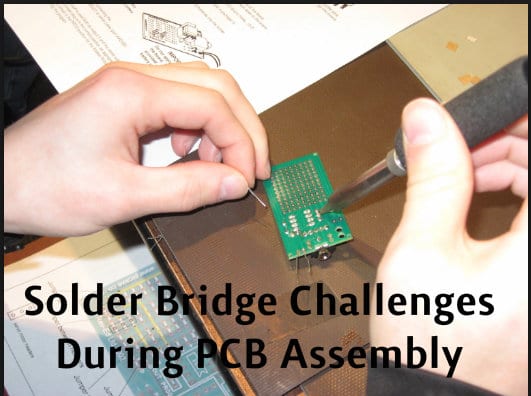Solder bridges aka shorts have become more challenging to deal with for those who fabricate or manufacture printed circuit boards. A solder bridge or short occurs when a solder is connecting and crossing one lead to another lead improperly. What makes them difficult to deal with is the fact that they are microscopic, which means that they can’t usually be detected by the naked eye making it hard to see if one is present.
What Cause Solder Bridging?
There are quite a few different scenarios that will result in the a short, or solder bridging. Understanding how this can happen can help you avoid this common and unnecessary problem. When we get down to the bare bones of the issue, it all comes down to a printed circuit board design that has a flaw. Because of this the original equipment manufacturer (OEM) is finding it difficult to find and create the exact layout for the PCB. Additional causes for solder bridges also include;
- Lack of solder resistance between the pads on the printed circuit board
- Not applying a sufficient layer of polymer on the copper traces
- If the device pitch is less than 0.5 mm the pad to gap ration will cause a short
- Incorrect stencil specification, leads to too much paste which leads to a solder bridge
- Excessive paste or an uneven distribution of it being used
- Stencil is too thin or too thick
- Mistake on the Surface Mount Component Placement
- Poor registration of the PCB-solder screen
Bigger and Better in Smaller Packages
One of the most amazing aspects of technology today is how our beloved gadgets are getting smaller and smaller! Although we love them we can’t overlook the fact that the smaller the package the more challenging in becomes. The smaller, delicate designs make mistakes more apt to happen which then increases the chances of a solder bridge occurring.
Can Solder Bridging Be Avoided?
The good news is that the answer to this question is an absolute yes. As we know, shorts are extremely difficult to identify before it is too late. This begins in the design process. Meeting with your fabricator/manufacturer and listening to their thoughts and expert advice when it comes to the fabrication process can prove extremely beneficial and definitely avoid some additional costly mistakes in the entire practice. Listening to the fabricator is important, it they do find a flaw in the design they can begin to immediately start developing a work around or an alternative solution that will ensure the successful completion of your printed circuit project.
Solder bridges (shorts) account for about 15% of the problems that fabricators can face while creating your printed circuit board. The best advice to follow is to be a careful as you can during the design process. Design flaws are normally the main reason for solder bridges. Finding the flaw or better yet not making a mistake in the design process would be the perfect way to avoid them!
Related:
CHOOSING THE PERFECT PCB ASSEMBLY PARTNER






